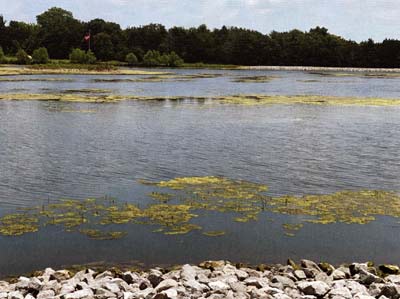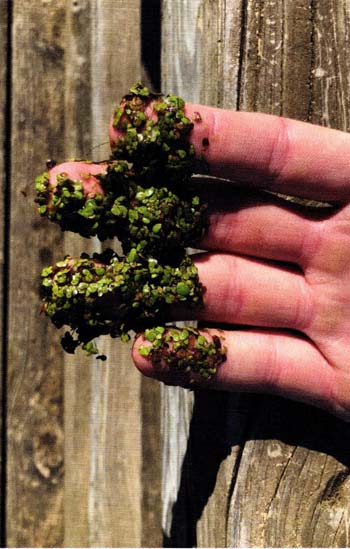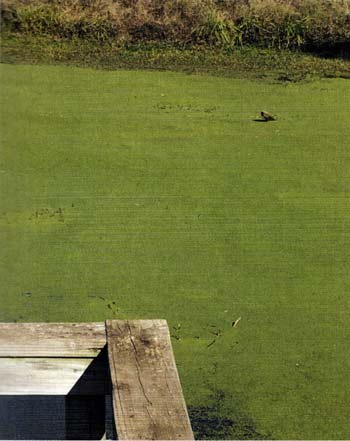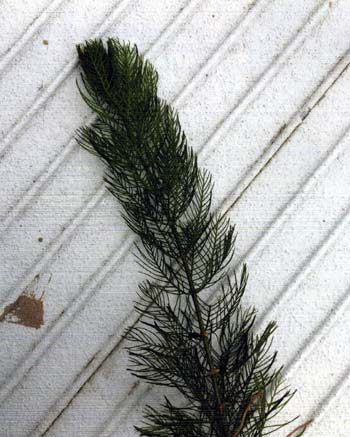
Pond pros and biologists are first to preach that stands of native aquatic plants serve a healthy purpose in our lakes and ponds.
Habitat.
That same group will also be the first to tell you that too much, too many, or invasive plants can be a big problem.. .especially in summer.
Pond owners tend to see their underwater greenery through different eyes than a biologist. A landowner sees problem plants based on different criteria. Why, you might ask? Plants are growing in the wrong place, too close to the dock, or in an area where the grandkids like to swim. Often, people see mats of plants and consider them unsightly. Unsightly is perceived as bad.
Let's sort this out to understand our underwater summer salad bar better.
First, you have to be the judge of what's going on under your water. Information is key. Start with the basics. For plants to grow, they need what I call "The Big Three". Plants need nutrients, sunlight, and temperature. Take away any of those three things, and plants won't grow. We can't do anything about the temperature. It's a chore to do away with food. But we can minimize sunlight penetration to the pond bottom and limit areas where plants grow. That's the traditional management strategy. But that process starts in spring, not in the heat of summer.

The second line of thought and information in this process focuses on identifying plants. You have to know which species of plants are growing to understand what to expect from them. Then, you can better predict the outcomes from possible action choices.
After you know why plants grow and you've identified the species, the next step is understanding those species and choosing what to do. Here we are, in the hottest months of the year, and you have areas where the plants have exploded. Those big mats of filamentous algae are mostly gone now, but lurking beneath those mats, back in May, were small batches of bushy pondweed competing for space with an egg-shaped bundle of coontail surrounded by some wispy Eurasian watermilfoil. Most people, in their steep, early learning curve, didn't think to look underneath those algae mats in the spring months. They
thought algae was the problem and figured out how to treat it. What they didn't think about was the consequences. Those mats blocked sunlight and competed for nutrients with other species beneath. When the algae was treated, died, and went away, it opened a sunshine pathway and released its nutrients to fuel those plants underneath... those that didn't die. Now, they've exploded, it's mid-summer, and almost half the pond is covered with plants.
To help understand the significance of identifying plants, take the species mentioned above, filamentous algae, bushy pondweed, coontail, and Eurasian water milfoil. Each species has different characteristics, habits, temperature windows, and growth methods. The better we understand those factors, the better decisions we can make when contending with them.
Take filamentous algae first. There are more than 15,000 species of that stuff. Some look like bright green angel hair, while others might resemble an olive-gray Brillo pad sans the soap. For the most part, in our ponds, the majority of filamentous algae begins its life in cooler months. The other three species in this example also have different temperature windows but prefer warmer. Filamentous algae grows quickly from the pond bottom, breaks loose, and forms mats. That growth cycle may take only a few days but is ongoing for weeks. When using an algaecide, we disrupt that lifecycle temporarily.

Bushy pondweed, or Southern naiad, resembles Bermuda grass with stems and blades. It's rooted in pond mud, gleaning its food from the bottom. It grows in thick mats and can be its densest by this time of year. No way to navigate through it. It wraps up your prop, tangles in your lures, and may be too thick for fish larger than three or four inches to make their way through it. It spreads year to year and manifests at the surface.
Coontail is different. That stuff isn't rooted, pulls its food from the water column, and migrates around the pond with wind and currents. I've seen it completely cover ponds, shore to shore, although it doesn't grow much deeper than three feet. I've even seen mats of it flow into the emergency spillway of a pond during a flood, slowing the water flow when it needed to flow the most. This is a plant; once you see a pod of it beginning to grow, you can literally pull out of the water and do away with it. Careful, though. It reproduces by fragmenting.
Speaking of fragmenting, Eurasian watermilfoil reproduces via seeds and
fragmentation. Its feathery look might seem appealing for use as a habitat, but it's so invasive the trade-off isn't worth it. It grows from pond bottom soils and invades fast.
As you can see, each plant lives a different lifestyle. In the summer months, plants have what they need to exhibit rapid growth. Some do. Others slow down. As you think through how you want to manage summer plants, keep these facts in mind and spend time learning about each species and how its lifestyle impacts your waters.
Even more importantly, think several steps past your treatment options when deciding what to do about plants this time of year. Can these plants be removed physically? Or are herbicides the best management practice now? After treatment, what will happen?
Part of your process is to decide what not to do. That's just as important. If you leave things alone, what should you expect?
From a biological point of view, 20-30% of your pond should have some sort of habitat, especially if your fishery is essential. Some fraction of that should be native aquatic plant life. In a perfect world, half to two-thirds of your pond's perimeter should have a ring of plants that extend out eight to ten feet.

If plants cover more than 30% of your pond or reside in unwanted places, there's the making of a problem. If a pond becomes more than 50% covered, it's serious. More than 50% expect significant pushback from Mother Nature. With 30% coverage, your fishery is affected. Small fish have more than ample harbor to escape being eaten. While your forage fish population expands rapidly, your game fish can't enter the cafeteria to eat. That may be a good strategy in your grander plan, especially in overcrowded bass lakes. You're giving the baitfish an advantage.
When a pond hits 50%-plus coverage, small fish aren't accessible at all. Game fish lose weight while the buffet line is full. That's not nearly the problem to expect when you get a few steamy hot, still, cloudy days. That much biomass of plant life can consume most of the oxygen in the water, causing a fish kill. No sun means respiration, and plants take up more oxygen than it produces.
What to do? We'll skip the admonishment for not handling it earlier in the year. If your pond has too much plant life to support, consider treating it in sections. Take out some, let it die, wait a week or ten days, and do the next section. Watch water color and monitor results. It may take four treatments in exceptionally bad cases.
Be careful not to trade problems. Too many dead plants decompose and release nutrients forming an algae bloom with 6-inch visibility may be worse than leaving half the plants until fall.
What happens if you do nothing?
That depends.
It depends on the species of plants. It depends on the percentage of coverage. It depends on how deep the plants grow. Take curly-leaf pondweed. I observed several lakes in upstate New York years ago. Curly-leaf pondweed was a minor plant, growing in a few areas mid-spring. When the temperature was right, that stuff blew up and consumed the entire shoreline habitat, outgrowing several other species of plants. Then, almost as fast as it erupted, it waned. Other species were catching up and competing. It made for excellent fish habitat. We strategized how to deal with the stuff, but it took care of itself.
Other species might not behave like this at all.
If you leave coontail alone, you can bet it will expand and show up again next spring.
If you have summertime plant issues, go through the process of understanding the plant and what to expect.
That makes for better decision-making.
Reprinted with permission from Pond Boss Magazine



